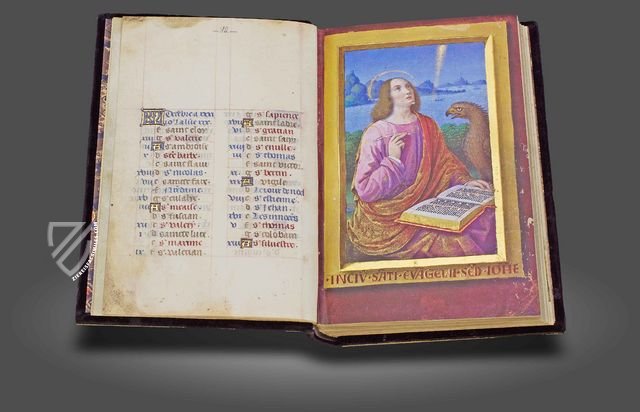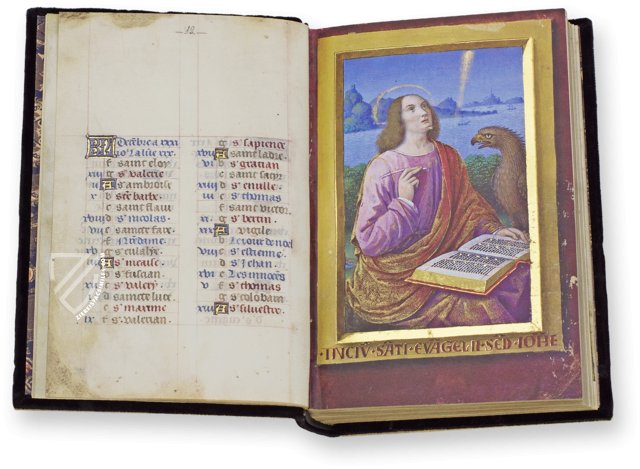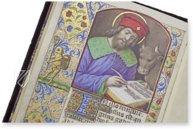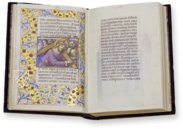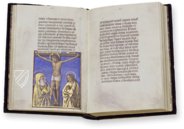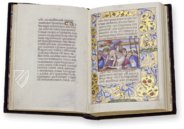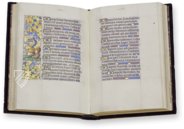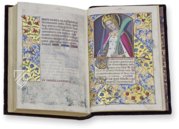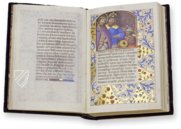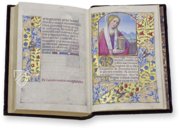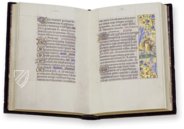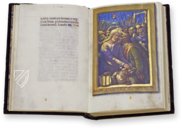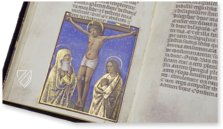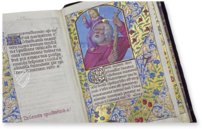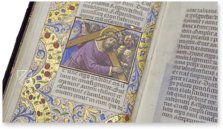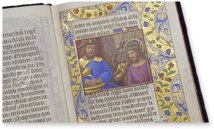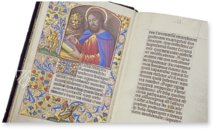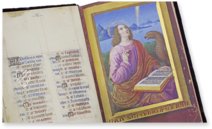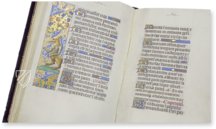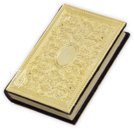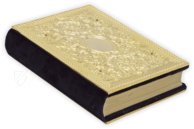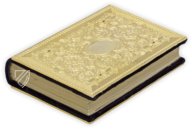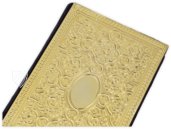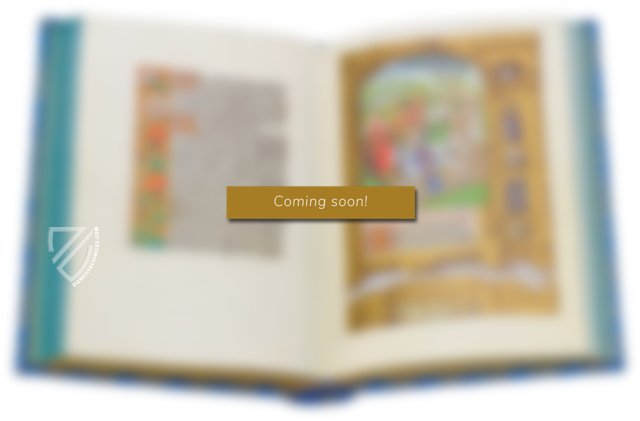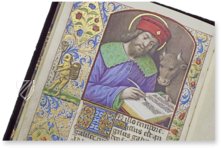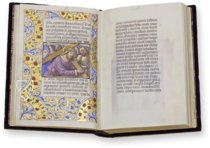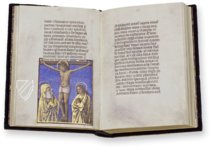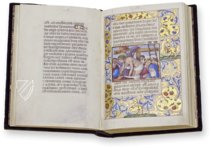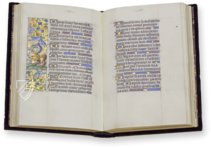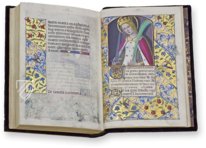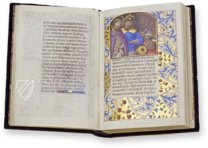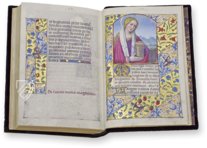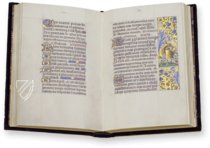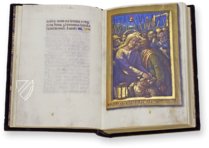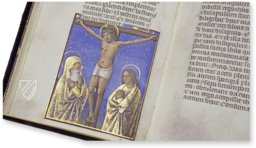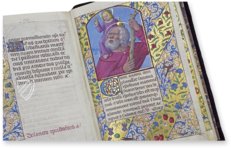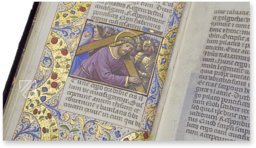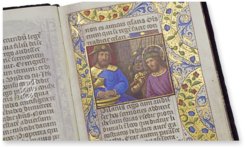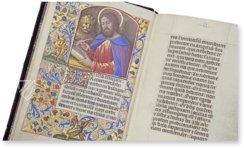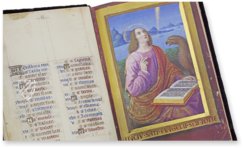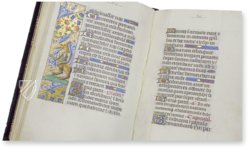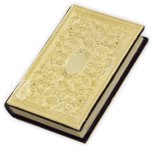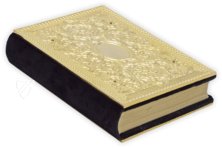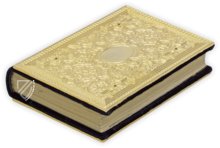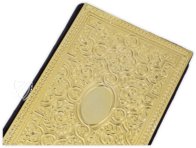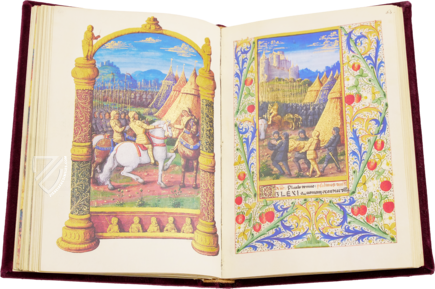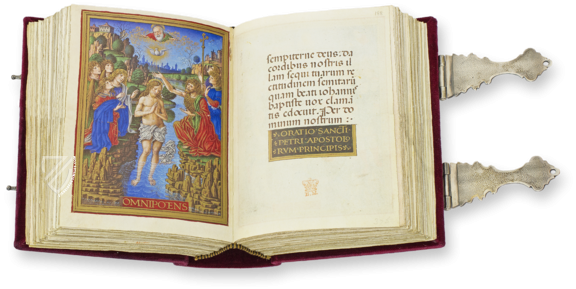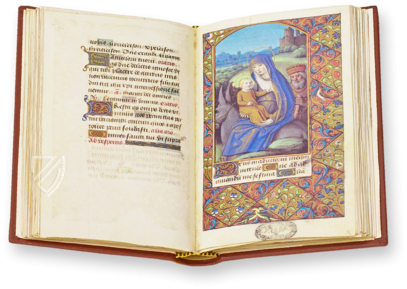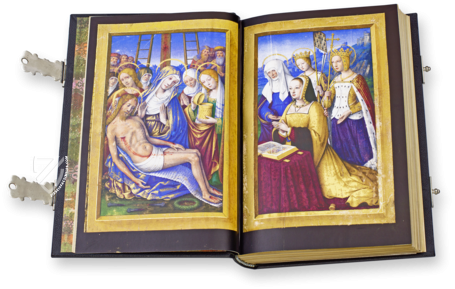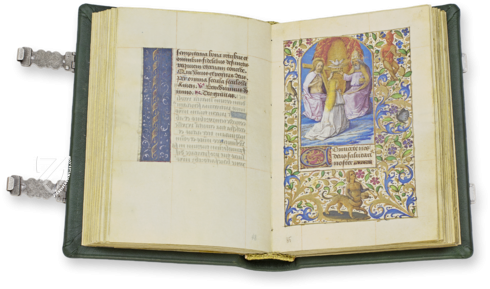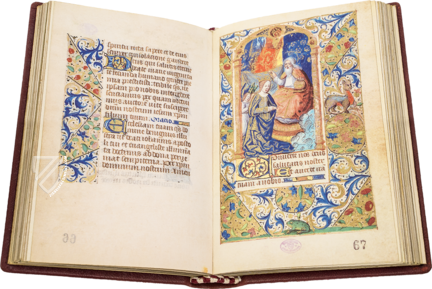Book of Hours of Ippolita Maria Sforza
(1,000€ - 3,000€)
This particularly artistically sophisticated book of hours was commissioned by Ippolita Maria Sforza (1446–1484). She belonged to the famous Sforza family, who ruled Lombardy from 1450 to 1535 as the dukes of Milan. For the book’s artistic furnishings, she engaged the painter and illuminator Jean Bourdichon (ca. 1457–1521), considered to be one of the most important artists of the Early French Renaissance. He embellished nearly all of the 300 pages with his intensely colorful and radiant miniatures, sweeping initials, and richly detailed bordures. Hundreds of plants and animals join the primary figures of biblical stories. As a result, the book of hours is nearly a complete medieval bestiary.
Book of Hours of Ippolita Maria Sforza
A book of hours is a layperson’s prayer and devotional book for the liturgy of the hours. These were especially popular among rich and literate nobles in the Late Middle Ages. An outstanding example thereof was commissioned by Ippolita Maria Sforza (1446–1484). She was a member of the Sforza family, who ruled Lombardy from 1450 to 1535 as the dukes of Milan. The illuminated manuscript originated ca. 1495–1504 in the French capital of Paris. The beholder finds full- or half-page miniatures, historiated initials, and decorative bordures on nearly all of its 300 pages. Moreover, the richness of the plants and animals is noteworthy, resembling a complete bestiary.
A French Illuminator
Jean Bourdichon, born in tours ca. 1457, is responsible for the intensely colorful book decoration. As one of the most significant artists of the Early Renaissance, he worked for the French kings Louis XI, Charles VIII, and Louis XII. Unfortunately, since only a few of his works have survived, the Book of Hours of Ippolita Maria Sforza represents a true rarity. The elegant style of the illuminator is distinguished by its fine painting style – he repeats short brush strokes over and over again. In doing so, he is able to achieve plasticity and thus describe the materiality of various matter. Garments thus appear soft and flowing, while the metallic armor has an iron glisten.
Atmospheric Landscapes
With Bourdichon, the typical execution of a gold background corresponds to an impressive landscape depiction. Whether merely serving as a background or not, the artist devotes serious attention to them. He reproduces a small fishing boat on a calm sea. Both castles and small cities are indicated on the highly coats. All of this is draped in blue evening light. In the miniature of the Betrayal, Bourdichon even augments the clear night sky with scattered stars.
A Rich World of Plants and Animals
Hundreds of depictions of plants and animals accompany the primary figures, not only in the markedly beautiful bordures, but also in the miniatures themselves. Thus, John the Evangelist appears accompanied by a splendid eagle. It sits to the left of John with an open beak and arrayed plumage. All things considered, the biodiversity of the animals depicted is so great that in this regard that the book of hours resembles a complete medieval bestiary. In doing so, it is a fable allegorically connecting the moralizing characteristics of animals with the Christian doctrine of salvation.
Codicology
- Alternative Titles
- Hours of Hippolyta of Aragon
Libro d'ore di Ippolita d'Aragona
Stundenbuch der Ippolita Maria Sforza
Grandes Horas de Montserrat - Size / Format
- 300 pages / 19.5 × 13.0 cm
- Origin
- France
- Date
- Ca. 1495–1504
- Epochs
- Style
- Genre
- Language
- Script
- Gothic Textura
- Illustrations
- Nearly all of the 300 pages of the manuscript are furnished with either full- or half-page miniatures, historiated initials and decorative borders with hundreds of plants, and a complete medieval bestiary.
- Content
- Book of Hours with texts for private devotion
- Patron
- Ippolita d’Aragona
- Artist / School
- Jean Bourdichon (ca. 1457–1521)
- Previous Owners
- Ippolita d’Aragona
Book of Hours of Ippolita Maria Sforza
Pilate Washing his Hands
This is an exemplary specimen of French Renaissance illumination: Christ is shown bleeding from multiple wounds and crowned with thorns as one of the guards points to him. Helmets and spears indicate a throng of soldiers behind them. “When Pilate saw that he could prevail nothing, but that rather a tumult was made, he took water, and washed his hands before the multitude, saying, I am innocent of the blood of this just person: see ye to it.” (Matt. 27:24).
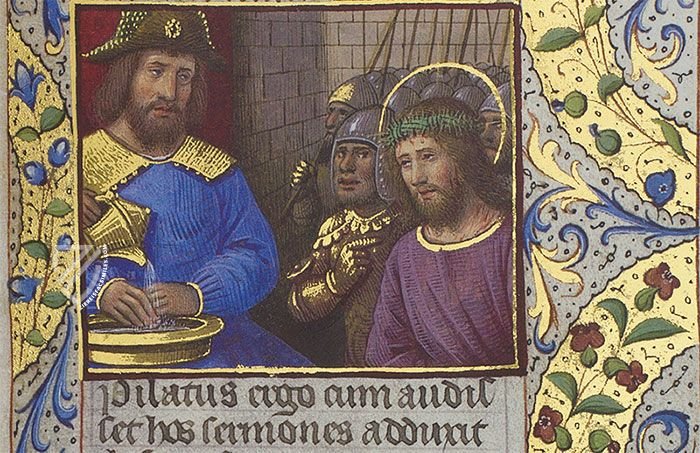
Book of Hours of Ippolita Maria Sforza
Portrait of John the Evangelist
Jean Bourdichon created some of the most splendid Evangelist portraits, including this miniature of St. John, the youngest of the Twelve Apostles. He is depicted here as a beardless youth with rosy cheeks and long hair – such feminized depictions were possibly intended to make him more relatable to women, especially in works intended for female patrons like this.
Flanked by his symbolic eagle, John’s purple tunic and red cloak are highlighted by the delicate application of gold leaf, with golden rays of divine inspiration coming down from above. The background consists of the Sea of Galilee, where he fished with his brother, James the Apostle. An illusionistic gold frame gives the miniature the appearance of a panel painting.
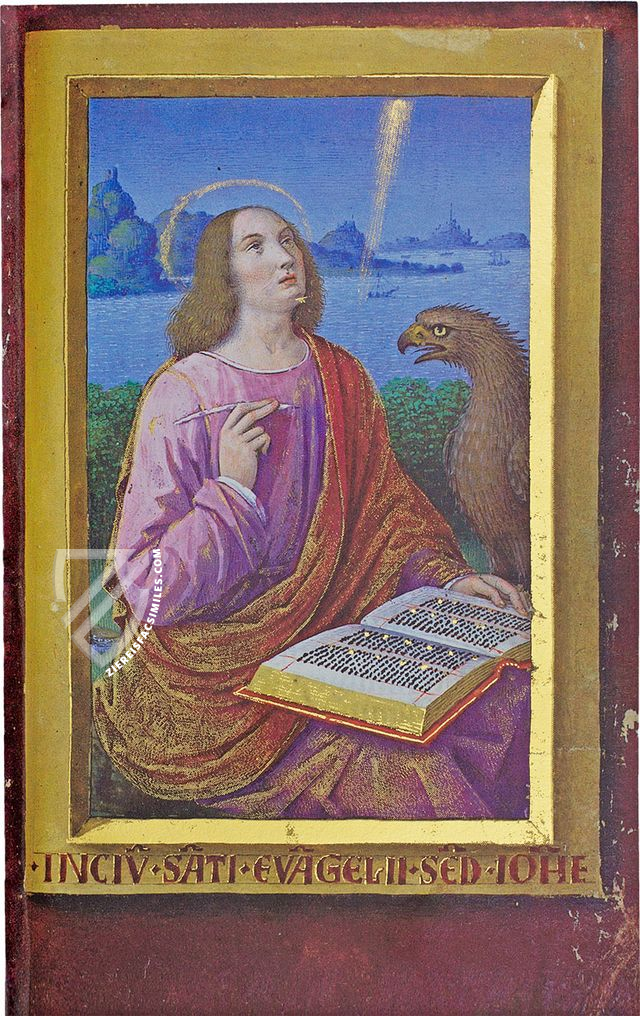
#1 Libro de horas de Hipolita de Aragon y Sforza (Grandes Horas de Montserrat)
Language: Spanish
(1,000€ - 3,000€)
#2 Triptico de Montserrat (Library Edition)
Language: Spanish
(3,000€ - 7,000€)
#3 Triptico de Montserrat (Deluxe Edition)
Language: Spanish
(over 10,000€)
- Treatises / Secular Books
- Apocalypses / Beatus
- Astronomy / Astrology
- Bestiaries
- Bibles / Gospels
- Chronicles / History / Law
- Geography / Maps
- Saints' Lives
- Islam / Oriental
- Judaism / Hebrew
- Single Leaf Collections
- Leonardo da Vinci
- Literature / Poetry
- Liturgical Manuscripts
- Medicine / Botany / Alchemy
- Music
- Mythology / Prophecies
- Psalters
- Other Religious Books
- Games / Hunting
- Private Devotion Books
- Other Genres
- Afghanistan
- Armenia
- Austria
- Belgium
- Belize
- Bosnia and Herzegovina
- China
- Colombia
- Costa Rica
- Croatia
- Cyprus
- Czech Republic
- Denmark
- Egypt
- El Salvador
- Ethiopia
- France
- Germany
- Greece
- Guatemala
- Honduras
- Hungary
- India
- Iran
- Iraq
- Israel
- Italy
- Japan
- Jordan
- Kazakhstan
- Kyrgyzstan
- Lebanon
- Liechtenstein
- Luxembourg
- Mexico
- Morocco
- Netherlands
- Palestine
- Panama
- Peru
- Poland
- Portugal
- Romania
- Russia
- Serbia
- Spain
- Sri Lanka
- Sweden
- Switzerland
- Syria
- Tajikistan
- Turkey
- Turkmenistan
- Ukraine
- United Kingdom
- United States
- Uzbekistan
- Vatican City
- A. Oosthoek, van Holkema & Warendorf
- Aboca Museum
- Ajuntament de Valencia
- Akademie Verlag
- Akademische Druck- u. Verlagsanstalt (ADEVA)
- Aldo Ausilio Editore - Bottega d’Erasmo
- Alecto Historical Editions
- Alkuin Verlag
- Almqvist & Wiksell
- Amilcare Pizzi
- Andreas & Andreas Verlagsbuchhandlung
- Archa 90
- Archiv Verlag
- Archivi Edizioni
- Arnold Verlag
- ARS
- Ars Magna
- ArtCodex
- AyN Ediciones
- Azimuth Editions
- Badenia Verlag
- Bärenreiter-Verlag
- Belser Verlag
- Belser Verlag / WK Wertkontor
- Benziger Verlag
- Bernardinum Wydawnictwo
- BiblioGemma
- Biblioteca Apostolica Vaticana (Vaticanstadt, Vaticanstadt)
- Bibliotheca Palatina Faksimile Verlag
- Bibliotheca Rara
- Boydell & Brewer
- Bramante Edizioni
- Bredius Genootschap
- Brepols Publishers
- British Library
- C. Weckesser
- Caixa Catalunya
- Canesi
- CAPSA, Ars Scriptoria
- Caratzas Brothers, Publishers
- Carus Verlag
- Casamassima Libri
- Centrum Cartographie Verlag GmbH
- Chavane Verlag
- Christian Brandstätter Verlag
- Circulo Cientifico
- Club Bibliófilo Versol
- Club du Livre
- CM Editores
- Collegium Graphicum
- Collezione Apocrifa Da Vinci
- Comissão Nacional para as Comemorações dos Descobrimentos Portugueses
- Coron Verlag
- Corvina
- CTHS
- D. S. Brewer
- Damon
- De Agostini/UTET
- De Nederlandsche Boekhandel
- De Schutter
- Deuschle & Stemmle
- Deutscher Verlag für Kunstwissenschaft
- DIAMM
- Droz
- E. Schreiber Graphische Kunstanstalten
- Ediciones Boreal
- Ediciones Grial
- Ediclube
- Edições Inapa
- Edilan
- Editalia
- Edition Deuschle
- Edition Georg Popp
- Edition Leipzig
- Edition Libri Illustri
- Editiones Reales Sitios S. L.
- Éditions de l'Oiseau Lyre
- Editions Medicina Rara
- Editorial Casariego
- Editorial Mintzoa
- Editrice Antenore
- Editrice Velar
- Edizioni Edison
- Egeria, S.L.
- Eikon Editores
- Electa
- Emery Walker Limited
- Enciclopèdia Catalana
- Eos-Verlag
- Ephesus Publishing
- Ernst Battenberg
- Eugrammia Press
- Extraordinary Editions
- Fackelverlag
- Facsimila Art & Edition
- Facsimile Editions Ltd.
- Facsimilia Art & Edition Ebert KG
- Faksimile Verlag
- Feuermann Verlag
- Folger Shakespeare Library
- Franco Cosimo Panini Editore
- Friedrich Wittig Verlag
- Fundación Hullera Vasco-Leonesa
- G. Braziller
- Gabriele Mazzotta Editore
- Gebr. Mann Verlag
- Gesellschaft für graphische Industrie
- Getty Research Institute
- Giovanni Domenico de Rossi
- Giunti Editore
- Graffiti
- Grafica European Center of Fine Arts
- Guido Pressler
- Guillermo Blazquez
- Gustav Kiepenheuer
- H. N. Abrams
- Harrassowitz
- Harvard University Press
- Helikon
- Hendrickson Publishers
- Henning Oppermann
- Herder Verlag
- Hes & De Graaf Publishers
- Hoepli
- Holbein-Verlag
- Houghton Library
- Hugo Schmidt Verlag
- Idion Verlag
- Il Bulino, edizioni d'arte
- ILte
- Imago
- Insel Verlag
- Insel-Verlag Anton Kippenberger
- Instituto de Estudios Altoaragoneses
- Instituto Nacional de Antropología e Historia
- Introligatornia Budnik Jerzy
- Istituto dell'Enciclopedia Italiana - Treccani
- Istituto Ellenico di Studi Bizantini e Postbizantini
- Istituto Geografico De Agostini
- Istituto Poligrafico e Zecca dello Stato
- Italarte Art Establishments
- Jan Thorbecke Verlag
- Johnson Reprint Corporation
- Josef Stocker
- Josef Stocker-Schmid
- Jugoslavija
- Karl W. Hiersemann
- Kasper Straube
- Kaydeda Ediciones
- Kindler Verlag / Coron Verlag
- Kodansha International Ltd.
- Konrad Kölbl Verlag
- Kurt Wolff Verlag
- La Liberia dello Stato
- La Linea Editrice
- La Meta Editore
- Lambert Schneider
- Landeskreditbank Baden-Württemberg
- Leo S. Olschki
- Les Incunables
- Liber Artis
- Library of Congress
- Libreria Musicale Italiana
- Lichtdruck
- Lito Immagine Editore
- Lumen Artis
- Lund Humphries
- M. Moleiro Editor
- Maison des Sciences de l'homme et de la société de Poitiers
- Manuscriptum
- Martinus Nijhoff
- Maruzen-Yushodo Co. Ltd.
- MASA
- Massada Publishers
- McGraw-Hill
- Metropolitan Museum of Art
- Militos
- Millennium Liber
- Müller & Schindler
- Nahar - Stavit
- Nahar and Steimatzky
- National Library of Wales
- Neri Pozza
- Nova Charta
- Oceanum Verlag
- Odeon
- Orbis Mediaevalis
- Orbis Pictus
- Österreichische Staatsdruckerei
- Oxford University Press
- Pageant Books
- Parzellers Buchverlag
- Patrimonio Ediciones
- Pattloch Verlag
- PIAF
- Pieper Verlag
- Plon-Nourrit et cie
- Poligrafiche Bolis
- Presses Universitaires de Strasbourg
- Prestel Verlag
- Princeton University Press
- Prisma Verlag
- Priuli & Verlucca, editori
- Pro Sport Verlag
- Propyläen Verlag
- Pytheas Books
- Quaternio Verlag Luzern
- Reales Sitios
- Recht-Verlag
- Reichert Verlag
- Reichsdruckerei
- Reprint Verlag
- Riehn & Reusch
- Roberto Vattori Editore
- Rosenkilde and Bagger
- Roxburghe Club
- Salerno Editrice
- Saltellus Press
- Sandoz
- Sarajevo Svjetlost
- Schöck ArtPrint Kft.
- Schulsinger Brothers
- Scolar Press
- Scrinium
- Scripta Maneant
- Scriptorium
- Shazar
- Siloé, arte y bibliofilia
- SISMEL - Edizioni del Galluzzo
- Sociedad Mexicana de Antropología
- Société des Bibliophiles & Iconophiles de Belgique
- Soncin Publishing
- Sorli Ediciones
- Stainer and Bell
- Studer
- Styria Verlag
- Sumptibus Pragopress
- Szegedi Tudomànyegyetem
- Taberna Libraria
- Tarshish Books
- Taschen
- Tempus Libri
- Testimonio Compañía Editorial
- Thames and Hudson
- The Clear Vue Publishing Partnership Limited
- The Facsimile Codex
- The Folio Society
- The Marquess of Normanby
- The Richard III and Yorkist History Trust
- Tip.Le.Co
- TouchArt
- TREC Publishing House
- TRI Publishing Co.
- Trident Editore
- Tuliba Collection
- Typis Regiae Officinae Polygraphicae
- Union Verlag Berlin
- Universidad de Granada
- University of California Press
- University of Chicago Press
- Urs Graf
- Vallecchi
- Van Wijnen
- VCH, Acta Humaniora
- VDI Verlag
- VEB Deutscher Verlag für Musik
- Verlag Anton Pustet / Andreas Verlag
- Verlag Bibliophile Drucke Josef Stocker
- Verlag der Münchner Drucke
- Verlag für Regionalgeschichte
- Verlag Styria
- Vicent Garcia Editores
- W. Turnowski Ltd.
- W. Turnowsky
- Waanders Printers
- Wiener Mechitharisten-Congregation (Wien, Österreich)
- Wissenschaftliche Buchgesellschaft
- Wissenschaftliche Verlagsgesellschaft
- Wydawnictwo Dolnoslaskie
- Xuntanza Editorial
- Zakład Narodowy
- Zollikofer AG

